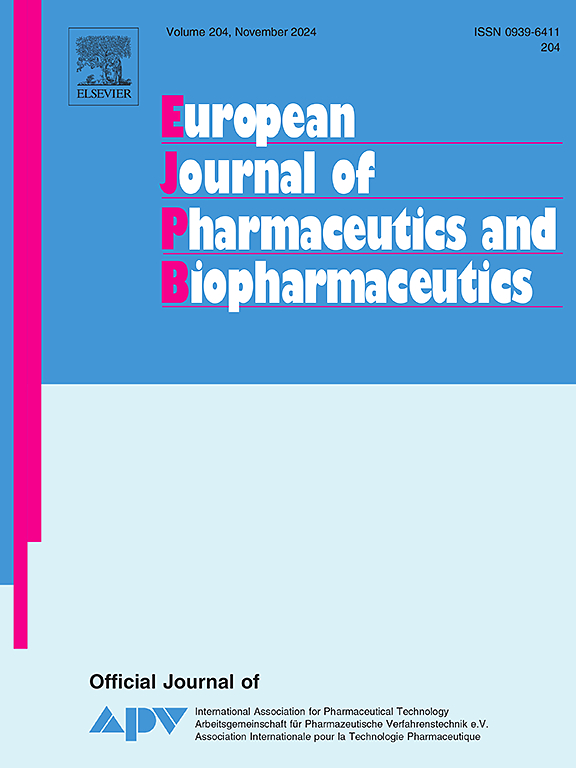流动成像显微镜分析Jurkat细胞在短期液体储存期间的稳定性。
IF 4.4
2区 医学
Q1 PHARMACOLOGY & PHARMACY
European Journal of Pharmaceutics and Biopharmaceutics
Pub Date : 2025-03-26
DOI:10.1016/j.ejpb.2025.114703
引用次数: 0
摘要
细胞基药品(CBMPs)的生存能力是一个关键的质量属性,必须在产品的整个生命周期中进行评估,以促进安全有效的药品。在这项研究中,我们研究了在制造CBMPs过程中遇到的短期液体储存条件(如细胞培养条件外的保存时间和培养基组成)对细胞活力的影响。Jurkat细胞被用作T细胞的模型,并在不同的储存介质中在冷冻室和细胞培养条件外储存长达24 h。研究了不同储存介质(即细胞培养基或磷酸盐缓冲盐水(PBS)、二甲基亚砜(DMSO))在不同储存温度下的储存效果以及pH对细胞活力的影响。通过(i) Annexin V和CalceinAM染色的流式细胞术或(ii)利用流式成像显微镜图像的形态学信息的机器学习工具来评估细胞的活力。通过流动成像显微镜获得的细胞图像使用ParticleSentryAI成像软件和卷积神经网络(CNN)进行分析,以进行快速和半自动的活力评估。在与CBMPs处理过程相似的整个储存条件下,基于Annexin V和CalceinAM染色,观察到细胞活力随着时间的推移而下降。此外,随着时间的推移,我们观察到DMSO的破坏性影响,而这种影响在室温下比在冷藏温度下更为明显。ParticleSentryAI软件可用于检测细胞活力的定性差异,因为在整个存储过程中,可以根据流动成像显微镜图像观察到细胞向非活细胞的转变,而无需事先制备样品。与流式细胞术相比,基于CNN的活力测定低估了细胞活力,但确定了相同的趋势。总之,CBMPs的非冷冻储存应保持在最低限度。然而,在整个CBMPs制造过程中以及在使用过程中,站立时间不能完全避免,因此,必须仔细评估最佳储存条件。此外,需要进一步的分析开发来实现适合可靠的活力量化的机器学习工具,而无需额外的样品制备(如染色)。本文章由计算机程序翻译,如有差异,请以英文原文为准。

Stability of Jurkat cells during short-term liquid storage analyzed by flow imaging microscopy
The viability of cell-based medicinal products (CBMPs) is a critical quality attribute and must be assessed throughout the product lifecycle to contribute to a safe and potent drug product. In this study, we investigated the impact of short-term liquid storage conditions, encountered during manufacturing of CBMPs, such as holding times outside cell culture conditions and medium composition, on cell viability.
As a model for T cells Jurkat cells were used and stored in different storage media for up to 24 h outside a freezer and outside of cell culture conditions. The effect of storage in different storage media, i.e., cell culture medium or phosphate buffered saline (PBS), dimethyl sulfoxide (DMSO) at different storage temperatures as well as the impact of pH on the cell viability was assessed. The viability of the cells was assessed by (i) flow cytometry with an Annexin V and CalceinAM staining or (ii) machine learning tools, leveraging the morphological information of flow imaging microscopy images. Cell images obtained by flow imaging microscopy were analyzed with both the ParticleSentryAI imaging software and a convolutional neural network (CNN) for fast and semi-automated viability assessment.
Throughout storage conditions similar to those during processing of CBMPs, a decrease in cell viability was observed over time for all conditions based on Annexin V and CalceinAM staining. Additionally, we observed a damaging effect of DMSO over time, whereas this effect was more pronounced at room temperature compared to refrigerated temperatures. The ParticleSentryAI software was useful to detect qualitative differences in the cell viability as a shift towards non-viable cells could be observed throughout storage based on flow imaging microscopy images without prior sample preparation. Viability determination based on the CNN underestimated cell viability when compared to the flow cytometry assays, however the same trends were determined.
In summary, non-frozen storage of CBMPs should be kept to a minimum. However, standing times throughout the manufacturing of CBMPs as well as during in-use cannot be completely avoided and therefore, the optimal storage conditions have to be carefully evaluated. Additionally, further analytical development is needed to implement machine learning tools suitable for reliable viability quantification without additional sample preparation such as staining.
求助全文
通过发布文献求助,成功后即可免费获取论文全文。
去求助
来源期刊
CiteScore
8.80
自引率
4.10%
发文量
211
审稿时长
36 days
期刊介绍:
The European Journal of Pharmaceutics and Biopharmaceutics provides a medium for the publication of novel, innovative and hypothesis-driven research from the areas of Pharmaceutics and Biopharmaceutics.
Topics covered include for example:
Design and development of drug delivery systems for pharmaceuticals and biopharmaceuticals (small molecules, proteins, nucleic acids)
Aspects of manufacturing process design
Biomedical aspects of drug product design
Strategies and formulations for controlled drug transport across biological barriers
Physicochemical aspects of drug product development
Novel excipients for drug product design
Drug delivery and controlled release systems for systemic and local applications
Nanomaterials for therapeutic and diagnostic purposes
Advanced therapy medicinal products
Medical devices supporting a distinct pharmacological effect.

 求助内容:
求助内容: 应助结果提醒方式:
应助结果提醒方式:


